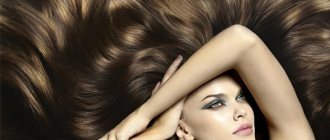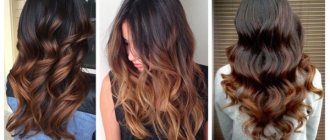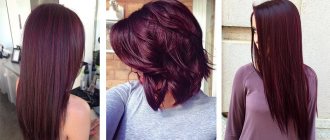Dyeing hair dark with folk remedies at home
Hair coloring with folk remedies is an excellent alternative to traditional chemical dyes. Not everyone can use conventional paints due to intolerance to certain components, allergies and other contraindications. Traditional methods can environmentally and safely dye your hair dark or light, hide gray strands and give your curls the desired shade.
Features of dyeing with natural dyes
Now there are many people who want to dye their hair using folk remedies, since it is easy to do at home.
The only drawback of natural paints is their instability; the painting procedure must be repeated every few weeks.
The time that the color will stay on the hair after dyeing at home will depend on individual characteristics.
Thus, thin hair holds color better and requires less time for the dyeing process. Before you start dyeing your hair at home, you need to prepare the necessary tools.
Folk remedies should be applied with a sponge or swab; you can also paint with a comfortable soft brush. It is also necessary to prepare a blanket to protect the shoulders from paint.
Before painting, you should wash your hair with regular shampoo.
Benefits of natural dyes
Hair dyeing using folk remedies is convenient not only because it is done at home. It also has many other advantages, including:
- Taking care of your hair.
- No irritation on the scalp.
- Naturalness of the resulting color.
- It is possible to change your hair color regularly.
- Providing a healing effect on hair and scalp.
- Low price for natural ingredients.
- Possibility of coloring gray hair.
To get the most pleasant experience from dyeing your hair with folk remedies, you should remember a few simple rules.
You cannot use natural dyes immediately after dyeing at a hairdresser. The process of saturating your hair with the desired shade is quite lengthy, so you shouldn’t rush and remove the dye in advance.
By following these rules, you can easily get good results at home.
Henna and basma
For dyeing hair golden color, henna is considered the best folk remedy. It is a powder from the leaves of alkana or lavsonia. Henna not only gives hair a pleasant color, but strengthens hair from roots to ends thanks to the presence of tannins. Its use at home is quite simple, and for health purposes it can be done weekly.
It must be remembered that henna is effective only on brown and light brown hair; its use on light hair gives a red-orange tint. To give dark hair color, henna is supplemented with basma. The proportions of these components affect the final result. So, if you take henna and basma in these proportions, it will turn out:
- A 1:1 mixture gives a nice chestnut color.
- Henna and basma in a 2:1 ratio will give a bronze tint.
- Henna and basma in a 1:2 ratio will result in a radically black color.
These indicators may vary slightly depending on your natural hair color. To correct saturation, you can reduce or increase the painting time. In addition, dyeing black hair with folk remedies will not give the desired result; the dark and golden color will not appear on it in any way.
To prepare dye from henna and basma at home, you should take their powders in the required proportions. The powders are poured into a glass bowl and mixed until the color is uniform. After this, hot liquid is added to the mixture; it can be either plain water, red wine or coffee. If desired, you can add drops of glycerin.
Next, hair coloring is divided into the following stages:
- Hair is washed with shampoo and slightly dried without using a hair dryer.
- The hairline is covered with Vaseline so that the dyes do not transfer to the skin.
- A mixture of basma and henna is applied along the parting lines using a sponge.
- To color the ends, add a little hot water to the remaining mixture.
- After thoroughly applying the dye, the hair should be hidden in a plastic bag and wrapped with a towel on top.
Depending on the desired shade, the paint should be kept for from 15 minutes to an hour and a half. After this time, the paint is washed off with warm water without using shampoo. If your hair is gray, dyeing with these folk remedies takes a little longer, but the result will be very good in any case.
Chamomile
Chamomile is an affordable and popular remedy for lightening hair at home. It has a soothing, softening and regenerating effect, and also gives hair shine and reduces excess sebum production. There are several recipes using chamomile flowers:
- 1 cup of dried flowers is poured with half a liter of just boiled water and left for two hours. 3 tbsp is poured into the infusion. l. glycerin, after which it is applied to the hair. The hair is wrapped in a plastic bag and a towel for one hour. This folk remedy can dye completely gray hair a golden shade.
- Dark hair can be lightened with chamomile in this way: pour one and a half glasses of flowers with 1 liter of vodka and leave for 14 days. After this, the infusion should be mixed with 50 ml of hydrogen peroxide, applied to the hair for half an hour, and then rinsed with regular shampoo.
You can also regularly rinse with a light chamomile decoction to give your hair a golden color.
Onion peel
Among folk remedies for dyeing hair at home, onion peels are popular. In addition to its long-lasting golden color, the husk gives shine to hair and eliminates dandruff. To dye your hair with onion skins, you should take:
- 0.5 cups finely chopped husks
- 1 glass of hot water
- 2 tsp. glycerin
The husk needs to be filled with water and brought to a boil. Keep on fire for 20 minutes from the moment of boiling, then cool and filter. Add glycerin to the broth and apply it to your hair with a clean sponge daily until the desired shade is obtained.
Walnut
Using the green peel of this nut, you can give a bright chestnut shade to your hair; this will look especially effective on light brown hair. In this case, the raw materials used can be dried and paint from the peel can be used at any time of the year. There are many ways to color walnuts, including the following:
- Add 1 tbsp to half a glass of any vegetable oil. l. alum, 1 tbsp. l. ground nut peel and 50 ml hot water. The mixture is placed on low heat and kept there for a quarter of an hour. Next, strain the mixture and apply the resulting cake to your hair. Leave the cake for 45 minutes and rinse with warm water.
- This recipe is simpler than the previous one. To make it, take the peel, ground in a meat grinder, and mix it with water, bringing it to the consistency of thick homemade sour cream. The product obtained in this way should be applied to the hair with a brush, left for 20 minutes and rinsed with water without shampoo.
- To achieve a lasting result you need 2 tbsp. l. pour 100 ml of alcohol into finely chopped green peel and leave for 24 hours. Apply the resulting infusion to your hair and leave for up to half an hour. This method gives noticeable and long-lasting hair color.
- There is another recipe for dyeing hair with walnuts. To do it, you need to pour 100 g of peel with a liter of water, put it on fire and boil the broth until it reaches two-thirds of the original volume. Filter the resulting broth and apply to hair, after half an hour, rinse with water without shampoo.
: Hair coloring with natural dyes
Rhubarb
Rhubarb gives ashen and light brown shades, and products made from it cover gray hair well. There are recipes based on rhubarb:
- Rhubarb root in the amount of two tablespoons is poured into a glass of water and boiled over medium heat for a quarter of an hour. The broth is cooled and filtered, after which 50 ml of apple cider vinegar or wine is added. The mixture is brought to a boil again and exactly half of the liquid is evaporated. The decoction is used to rinse hair after regular washing.
- Rhubarb leaves and roots in an amount of 200 grams are poured with unsweetened white wine and boiled by half. The decoction is used to rinse hair after washing to give a light shade to oily and normal hair.
Caring for colored hair
Any impact on the hair negatively affects its quality. Hair becomes more brittle and lifeless. To restore their beauty and elasticity, you must adhere to the following rules:
- use shampoos, balms and conditioners for colored hair, they will not only revive your hair, but also help maintain its color longer;
- make masks once a week;
- take vitamins and minerals;
- Avoid prolonged exposure to sun and cold.
Caring for blond hair is complex and scrupulous. But you can easily switch from blond and light brown to almost any other color. In addition, blondes have always attracted the attention of men. And modern dyeing techniques allow you to choose the most suitable light shade for yourself.
Detailed answers to important questions about hair coloring:
- how to dye your hair at home;
- what is hair emulsification when dyeing;
- Is it possible to dye your hair while breastfeeding?
- why it is not recommended to dye your hair during menstruation;
- hair coloring during pregnancy;
- how often can you dye your hair;
- how to quickly restore hair after dyeing.
Hair coloring with folk remedies – Vseznaykin
Are you looking for a solution on how to dye your hair using folk remedies? It is. Read our Health Recipes and use ingredients that will not harm, but will only improve the appearance of your hair.
Nowadays it is not a problem to buy industrial paint from any manufacturer, any color and for any money. There is a great temptation to repaint yourself in some unusual color - just in case it suits you. Then repaint again. Once again.
And then we are surprised - the strands are faded, dry, lifeless - nothing to look at.
If this is exactly the situation you have, try using dimexide masks, which will literally revive the health of your strands. When the hair is weakened, many begin to look for other opportunities to dye it, and at the same time make it healthier. Fortunately, you can find them. Just don’t expect quick results from coloring with folk remedies. After all, everything that is natural acts slowly and reliably.
Pros and cons of hair coloring with folk remedies
There are quite a lot of advantages when painting with folk remedies:
- Folk remedies do not act aggressively, they treat the structure with care.
- Does not irritate the scalp.
- The color does not change radically.
- Allows you to frequently change the desired shades.
- They often have medicinal properties.
- The products used for painting are inexpensive and easily available.
But there are also significant disadvantages:
- Color instability (usually until the first wash).
- The complexity of making a coloring composition at home.
- Unpredictability of the obtained result.
- Not recommended for use after chemical dyeing.
- Lengthy painting process.
The most popular folk remedies for coloring
These are, of course, vegetable dyes - basma and henna. They have been known since ancient times and enjoy well-deserved love.
1. It is customary to dye dark, but not black, hair with henna, which produces beautiful golden shades. If you dye very light strands with henna (for example, bleached with hydrogen peroxide), they will turn carrot-colored, bright red, even red. On black hair, henna does not work at all.
2. Basma in its pure form is rarely used, as it gives an extravagant green or green-blue color. It is usually used mixed with henna in different proportions:
- 1 part basma and 1 part henna gives chestnut color
- 1 part basma and 2 parts basma will give a bronze tint
- 1 part henna and 2 parts basma will be dyed black.
In addition to the composition, the coloring time is important: the shorter it is, the weaker the selected tone. Dark shades require up to 1.5 hours of coloring, and light shades require about half an hour. Coloring with henna and basma is quite durable and can last up to a month. If you want to strengthen the roots without changing the color, use colorless henna; it makes the hair soft and silky.
Lightening with folk remedies
1. Onion skins can be used to dye your hair, not just eggs for Easter. The solution from the husks will give them a golden color with a brownish tint.
It is not difficult to prepare - add 30 grams of husks to water (200 grams) and boil for about 20 minutes.
Add a couple of tablespoons of glycerin to the strained solution and moisten the strands daily for two weeks to the desired shade. When the solution runs out, it is prepared again.
2. Lemon juice can significantly lighten your hair. To do this, mix the juice in half with vodka and apply the composition to clean and dried curls. We must remember that vodka (more precisely, alcohol) dries, and if they are initially dry, then you should not use such a composition. But if your hair is oily, the effect will be good.
3. Not only jam is made from rhubarb, but also hair dye. You just need to take the roots of this plant: for 250 grams of water, about 40 grams of crushed root. Cook for 15 minutes, strain, cool. Rinse the washed strands with the prepared broth; they become light brown or ashy in color.
Dyeing dark shades using natural products
1. Beautiful brown color comes from linden flowers. Pour 4 tablespoons of dry or fresh raw materials with 200 grams of boiling water and leave on low heat. When the liquid has evaporated by 1/3, it is filtered, cooled and applied. This is done in four steps, without rinsing, with complete drying in between. The process is time-consuming, but it's worth it.
2. To obtain a soft brown color, you can use natural coffee. This method is simple, fast and enjoyable. First of all, wash your hair with shampoo, brew two large cups of natural coffee, strain. Use one cup to rinse your hair, drink the other cup yourself :)
3. Painting yourself black is especially convenient in winter, after the New Year. Find discarded Christmas trees on the street (if you don’t have your own), and collect the bark from them. By this time it has already dried well and comes off easily. Break it into pieces and grind in a coffee grinder. Brew this powder with boiling water and leave for about an hour. Strain and apply to hair, leave for no more than an hour, rinse.
Touching up gray hair
1. Gray strands are not easy to hide. If your hair is light and there are few gray hairs, you can use chamomile infusion, it gives a golden hue. The decoction is easy to prepare: pour 100 grams of chamomile with boiling water (0.5 liters), let it brew for 40 minutes and strain. Moisten clean hair with the broth and leave for an hour.
2. Another well-known remedy is black tea. It covers gray hair efficiently and for a long time and gives a beautiful shade. The product is easy to prepare: 2 tbsp. Pour half a liter of boiling water over spoons of tea leaves and leave on low heat for at least half an hour.
Wet your hair with the resulting solution, put on a bathing cap and sit for half an hour.
If you add a couple of teaspoons of instant coffee to the resulting broth, you will get a brown tint, and if you add onion peels to the water during boiling, the tint will become copper.
3. If your hair has become completely gray and you cannot dye it with industrial dye for some reason, you can rinse it with a weak solution of purple ink. This solution will remove unpleasant yellow shades and add airiness.
Some recommendations
- Paint made with your own hands does not always work immediately.
- House paint is applied with a brush or sponge along the entire length of the strand.
- When dyeing your hair with basma or henna, you can add a little kefir to the solution, you will get a good mask.
- Henna is not suitable for gray hair.
- Chemically curled hair also cannot be dyed with henna or basma.
- It is necessary to properly care for colored hair.
Vyuga Bokova has collected recipes for healthy and beautiful hair.
Natural hair dyes are given by nature
Are you looking for a solution on how to dye your hair using folk remedies? It is. Read our Health Recipes and use ingredients that will not harm, but will only improve the appearance of your hair.
Nowadays it is not a problem to buy industrial paint from any manufacturer, any color and for any money. There is a great temptation to repaint yourself in some unusual color - just in case it suits you. Then repaint again. Once again.
And then we are surprised - the strands are faded, dry, lifeless - nothing to look at.
If this is exactly the situation you have, try using dimexide masks, which will literally revive the health of your strands. When the hair is weakened, many begin to look for other opportunities to dye it, and at the same time make it healthier. Fortunately, you can find them. Just don’t expect quick results from coloring with folk remedies. After all, everything that is natural acts slowly and reliably.
Hair coloring with folk remedies at home - recipes and tips
Hair is the wealth and pride of every person. Their healthy appearance guarantees a good mood and a positive attitude. Sometimes, in addition to normal daily care and hygiene procedures, they need additional methods of protection.
Coloring allows you to get rid of gray hair, change the shade, and refresh your overall appearance. Visiting beauty salons takes time, procedures require financial expenses, and the result is not always satisfactory.
In this case, coloring is best done at home using folk remedies.
Benefits of using traditional recipes
Folk remedies will allow you to change or adjust your hair color, cover gray hair or experiment with shades. Their main advantage is the complete absence of harmful components. The choice is also influenced by:
- naturalness and environmental friendliness;
- safety (folk remedies call natural ingredients);
- ease of use.
The affordable cost of ingredients and good results also influence the choice of dyeing at home with folk remedies.
Color range of paints
Without using chemical ingredients, you can change your hair color dramatically. Proven and safe folk remedies will help with this. With their help, your hair will not only change its shade, but will also restore lost health, since most of the components in coloring compositions are natural substances.
If desired, you can easily lighten your hair by several tones or, conversely, darken it, get rid of gray strands or do highlighting. The color range is varied - from rich red shades to natural ones.
The recipe for each composition is not difficult to reproduce at home, since this does not require special skills or knowledge.
Rich red shades
Owners of fiery hair need to maintain the color and ensure that the hair looks natural. The recipe is also suitable for those who want to experiment to find out whether this shade suits them. The recipe for preparing the coloring mixture is simple. Required:
- natural henna – 1 sachet;
- cocoa (powder) – 3 tsp;
- warm water.
All ingredients should be mixed and water added. Its quantity is determined by the consistency of the mixture - it should be similar to sour cream. The resulting composition is applied to the hair for 50-60 minutes, after which it is washed off under running warm water. Finally, the head should be washed with shampoo (it is recommended to choose one without alkali).
In order to dye your hair red or refresh this natural hair shade, you will need:
- Indian henna (natural) – 1 sachet;
- coffee – 5 tsp;
- water – 10 ml.
All bulk components are mixed. They should be diluted with water to the consistency of porridge. The mass is applied to the hair and left for 45 minutes. During this time, your head should be wrapped in cellophane for better results. Rinse off with warm water.
Noble chestnut
Changing your hair color to brown using folk remedies is not difficult - for this you will need:
- olive oil – 1 liter;
- alum – 2 tbsp;
- water – 100 ml;
- green walnut peel - 2 tbsp.
The recipe assumes that olive oil can be replaced with any odorless vegetable oil. All ingredients are mixed, the resulting mass must be cooked for 10 minutes over medium heat. After this it should cool down.
The dyeing composition is applied to dry hair, the exposure time is 60 minutes. This recipe will not only achieve intense color, but also has a healing effect - it returns shine and eliminates oiliness.
It also gets rid of gray hair.
Fashionable golden
If you don’t like the dark color, then using folk remedies you can lighten your hair a little. Coloring composition recipe:
- onion peel (onion) – 1-2 cups;
- water – 500 ml.
The ingredients are mixed, after which you will need to make a decoction. It is applied to clean hair for half an hour. As a result, the color of your hair will have a golden hue. Among light shades, light red is popular. In order to get it you will need:
- chamomile – 4 tbsp;
- water – 0.5 liters.
The resulting infusion is applied to the hair and left for 20 minutes, then the procedure should be repeated 2-3 more times. The recipe allows you to additionally get rid of flaking skin on the head and relieve possible inflammation.
Coloring in a bright golden color using folk remedies:
- henna – 1 sachet;
- chamomile decoction.
The recipe assumes that the composition should be similar in thickness to sour cream. Exposure time – 60-70 minutes.
If you mix henna and basma in a 2:1 ratio, you can get a very beautiful bronze shade. The composition is excellent for gray hair. Exposure time 40-50 minutes. It is best to wash off the composition with warm water using a non-alkaline shampoo. At home, coloring is done efficiently if the timing and proportions of all components are respected.
Thus, you can get rid of gray hair or change its color at home just as quickly and efficiently.
Using a recipe based on folk remedies, your hair will acquire the desired shade, and will also regain health and strength, since coloring takes place without exposure to chemical components. Coloring without harm is a dream that is real.
With plant-based products you can get rid of gray hair at home in just a few minutes. Any folk method of hair care allows you to treat and restore it.
Client's instructions for coloring
- do not hide information from your hairdresser . If you dyed your hair with henna, say so; if there were unsuccessful dyeing attempts, there is no need to keep it silent. The master asks about this not out of curiosity, but in order to select the necessary means and predict the result. After henna, for example, even colorless, the noble chocolate color of the dye may well turn green on your hair;
- do not hesitate to ask the master to conduct a test . The test answers 2 questions at once - it helps to exclude an allergic reaction and predict how the hair will react and what kind of reaction it will give to the dye;
- try to clearly formulate what you want to get as a result . It is not enough to say that you want a copper color - the perception of copper between you and the master may be different. Ideally, prepare examples of the shades you like - they can be found on the Internet. Achieving the desired result is a joint work of both the master with his professionalism, and the client with understanding, thoroughness and certainty;
- During the dyeing process, be interested in the process, especially the holding time of the compositions . It often happens that the master applies the composition to the hair and goes to drink tea, forgetting about the client. The girl, having no idea how long to keep the dye on, humbly waits, and in the end leaves with burnt and brittle hair. Don’t be afraid to remind yourself once again;
- do not go to beauty salons, where the cost of painting is suspiciously low . Balayage or air touch cannot cost 800 rubles, even for short hair. If the price tag is very low, most likely the hairdresser works with low-quality dyes, and they are much more harmful to the hair shaft than professional dyes and oxides.
Natural methods of hair coloring at home - recipes
Changing hair color without harm is not a myth; before the advent of ammonia dye, women used only folk remedies. Lightening or coloring with a therapeutic effect was achieved using components tested for decades.
Natural coloring is safe, it does not damage the hair structure, does not destroy the ends, and has a beneficial effect on growth and thickness. Be careful, some components cause a severe allergic reaction. A sensitivity test should be performed.
Natural coloring methods include:
- Lightening with spices;
- Coloring with honey;
- Coloring with onion skins, rhubarb, coffee, mustard, etc.;
- Coloring with henna and basma.
Vegetable based paints
Plant-based paints include henna (lavsonia), basma and other components that do not contain hydrogen peroxide. These dyes are recommended for use by women who have not previously experienced the effects of permanent dye or have not been exposed to other chemical influences, such as carving, perm, lamination, etc.
There are two types of staining:
- Joint (when two or more components are used);
- Separate (use of one or alternate use of components);
- The first type also includes mixing ingredients at different temperatures.
Coloring with henna and basma
Dyeing your hair with herbal ingredients always gives an unpredictable result. You will never be able to get the same color. High-quality lavsonia will give a bright and rich shade, which will primarily depend on the original hair color.
To obtain a copper, red tint for medium-length hair you will need:
- 100 g of henna;
- A glass of kefir or water;
- Glass bowl;
- A brush for painting, a spray bottle with water and a drop of aroma oil.
Henna needs an acidic environment to open faster; you can use heated lemon juice.
Heat kefir in a water bath to body temperature, add henna, stir. Let it brew until the kefir cools completely.
Preparing for coloring:
- Comb and lightly spray the entire head with a spray bottle (the oil will open the hair scales and the natural dye will penetrate deeper, which will give a more saturated and lasting color);
- Cover the floor with newspapers;
- Throw a towel over your shoulders;
- Prepare a plastic cap or bag.
You need to start staining from the back of the head, gradually moving towards the forehead and ears. The dye is applied to the entire length of the hair, starting from the roots. Upon completion, you should wrap your head in a prepared hat or bag. The time depends on the desired shade. 1.5-2 hours will be enough for a lasting copper color. Exposure for up to 1.5 hours will give a rich rusty orange color.
Coloring with basma without lavsonia is extremely undesirable. Pure basma can give your hair a blue tint or a “raven wing” color. To avoid this, you should mix basma with henna in the following proportions:
- 1:1 - to obtain black color;
- 1:2 - to obtain a chocolate color;
- 1:3-3.5 - to obtain chestnut shades.
The technology for preparing and applying paint is identical to the above. To obtain black color you will need 50 grams of basma and 50 grams of henna. Exposure time from 2 to 7 hours. The lighter the initial hair color, the less time it takes to obtain the desired shade.
If desired, you can give the henna a coffee-chocolate shade; to do this, add a tablespoon of ground coffee to the initial composition.
To obtain a chestnut color, brew this herb in a decoction of onion peels or oak bark. Pour the husks into a thick-bottomed pan, add water and boil for 15-20 minutes. Cool the resulting solution to 60 degrees, pour henna over it. Dye your hair as you would with regular dye. Exposure time is 30-90 minutes for light brown hair.
How to remove hair dye to natural color
Permanent dye can be removed in just a couple of weeks. For this you will need:
- Any essential oil;
- Cinnamon, mustard or ground ginger;
- Lemon juice;
- Laundry or tar soap.
Washing with oil and spices:
- Essential oil is applied to a clean head. This is required so that the hair scales open and let in spice particles. The oil should be kept on the head for at least 20 minutes, after this time, rinse with warm water without soap or shampoo. Dilute 5 tablespoons of cinnamon in one and a half liters of water. Shake and rinse your hair with this solution, then wash with shampoo as usual. Ginger or mustard can be used instead of cinnamon.
- You can return your hair to its original color using lemon juice and laundry soap . This composition dries the scalp, but quickly and practically without harm returns it to its natural color. A simple conditioner or balm will help restore the ph balance of the skin.
- To wash off the dye, you need to wash your hair well with laundry or tar soap, then squeeze the juice from 1-2 lemons, depending on the length of the hair. Moisten your hair with lemon juice, try to soak it entirely without touching the roots. Leave overnight. In the morning, wash off using shampoo and conditioner. Repeat the procedure 1-2 times a week.
Natural dyeing methods will save your nerves and not lighten your wallet. You should approach this process creatively and in a good mood, then everything will definitely work out.
Reviews
y. idilika
I did a lot of different experiments with my hair. I dyed them and bleached them, but in the end, I still came to the conclusion that natural hair dyes are much better and safer.
There were successful and not very successful experiments. Henna + various additives (turmeric, coffee, kefir), all of this gave different shades and degrees of saturation. Ultimately, I just started diluting and using this weed according to the recipe on the package.
Once, when I got very stressed at work, I even fell asleep with this composition on my head. Nothing bad happened, the effect was the same as after two hours. To prevent anything from getting dirty, you should definitely wear an unnecessary T-shirt.
Cover the floor with film, provide a special towel that you don’t mind. And be sure to use gloves, henna does not wash off the skin for a very long time.
Loading…
Partial staining
You can refresh your hairstyle based on a natural light brown color by partially dyeing your curls. Complex processing of strands (shatush, balayage) is performed using 1 or several dyes. It is recommended that the procedure be performed by an experienced specialist. A good knowledge of color and artistic taste is required. The master, assessing the appearance, randomly distributes strokes, creates a real masterpiece. The result is distinguished by the beauty of the play of glare.

On light brown hair, you can perform ombre (partial dyeing technique). Only treat the area at the roots or ends. A smooth color transition gives an interesting effect. The technique refers to gentle coloring options. Ombre can be done on naturally dark and light curls.

Natural hair dyes are given by nature
Today in any supermarket you can buy hair dye with the shade you like. But many girls, trying to protect their curls from the harmful effects of industrial dyes on the structure, often ask the question whether there are harmless folk remedies that can be used to solve the problem of coloring.
Our grandmothers and great-grandmothers also dreamed of being young and beautiful for as long as possible. And they knew the secrets of lightening and dyeing hair using folk remedies. Some secrets have survived to this day and are actively used at home.
Red and ginger shades
Our hair needs constant care, but if we decide to give it a new shade, folk remedies will come to the rescue.
If you decide to dye them a rich mahogany color, you need to prepare one bag of natural henna, mix it with three tablespoons of cocoa powder and then dilute these ingredients with hot water until the consistency of sour cream. The mixture is applied for one hour. After this, it is washed off with warm water and some natural (non-alkaline) shampoo.
You can very simply, if desired, dye your blond hair red. You need to mix a bag of Indian natural henna with five spoons of coffee. The ingredients, diluted with water to a mushy state, are applied and kept for at least 45 minutes, making sure to cover your head with cellophane film or a shower cap.
Chestnut shades of strands can be obtained using green walnut peels.
Prepare the dye: 1 liter of olive oil (you can also use other vegetable oil), two tablespoons of alum, two tablespoons of finely ground peel - mix thoroughly and add 100 milliliters of boiling water. The composition is boiled over fire for 10 minutes, cooled.
This mixture is evenly distributed and left to stain for 1 hour. Wash off the paint with warm water. It not only gives a beautiful shade, but also provides shine and dries oily hair.
Giving a golden hue
With the help of onion peels, our ancestors gave their hair a golden hue. You need to fill a glass (or more) with 500 ml of water, boil it, and when the broth has cooled and infused, apply it to clean curls for 20 minutes. After the procedure, the head is rinsed with warm water.
To get a golden or light red tint, you can do the following. Four tablespoons of chamomile inflorescences are poured with boiling water in the amount of one liter of water. Let it brew, and then the folk remedy is applied to the hair. The procedure is repeated several times in a row.
Another chamomile recipe. You can get a golden hue using this recipe. Pour three glasses of vodka into a glass of chamomile flowers, leave it in a dark place for two weeks, and then add 80 ml of peroxide to the infusion. The composition is evenly applied to the hair and left for no more than 1 hour. Next, the strands are thoroughly washed with warm water and shampoo.
Henna mixed with chamomile decoction will give a bright golden tone. You will need one packet of henna; it is diluted with a hot chamomile decoction. The mushy mixture must be kept for at least an hour.
A very beautiful bronze shade is obtained by performing the following steps. Mix two parts natural henna and one part basma. The mixture is diluted with hot water until creamy and applied to the hair for 45 minutes. Wash off with warm water and shampoo.
Gray hair coloring
Gray hair can be rinsed with a strong infusion of black tea. They will acquire a natural straw yellow color.
Dark curls can be dyed light brown with rhubarb. To prepare the dye, take 30 grams of the root and leaves of the plant, grind the raw materials into a fine mass and pour half a liter of wine (necessarily white!). Then place the container with the ingredients on the stove and boil everything for half an hour at the lowest temperature. The cooled mixture is applied to the hair for 45 minutes.
Dark colors
Lovers of black hair can use this dye without any harm. Henna and basma are diluted in water in equal parts, the mixture is applied and kept for one hour, wrapping the head in film and a towel. Wash it off with hot water using shampoo for dark hair.
You can get a brown tone at home by preparing this paint. Three tablespoons of black tea are poured into a glass of boiling water and placed on low heat for 25 minutes. When the mixture has cooled, apply it to clean hair for 20 minutes. Wash off with warm water.
List of products that help change hair color
Almost all women who take care of themselves using home remedies know about the existence of natural dyes. The most popular of them are chamomile, henna, onion peel, etc. We will look at what products are natural dyes and their properties below:
- Chamomile . This plant helps lighten curls and make them strong and shiny.
- Henna . Colors curls red, and also helps strengthen and smooth curls.
- Basma . Used only with henna; if you ignore this rule after dyeing, you will become the owner of green hair. With the correct dosage of both components, the hair will turn brown or black.
- Coffee . The hair will take on a chestnut hue. This product also strengthens the strands and makes them strong and energetic.
- Onion peel . This raw material dyes the curls golden (light curls) or dark chestnut (dark curls) color, strengthens them and stops the process of hair loss.
- Rhubarb root and leaves . Repaints hair ashy or light brown, makes it full and shiny.
- Walnut peel . Recolors strands in a chestnut shade, strengthens them and adds shine.
- Black tea . Colors curls in brown shades, and also stops hair loss and strengthens roots.
- Cocoa . Gives strands a mahogany shade, enhances growth and prevents split ends.
- Blackberry . These berries color the curls in a red-brown color, and also nourish them with vitamins and nutrients.
- Spruce bark . Colors curls black and also nourishes with beneficial substances.
- Lemon . Lightens curls, combats dryness and split ends.
- Sage . Gives hair a dark color, and also strengthens it and stops hair loss.
- Linden . Recolors strands brown, treats dandruff and split ends, strengthens and nourishes follicles, makes curls strong and shiny.
- St. John's wort . Gives hair a reddish tint, strengthens and tones the roots, and fights increased oiliness in the dermis of the scalp.
All of the above products can be easily found in a pharmacy or supermarket in any city. Using a natural dye will not only change your hair color, but will also have a beneficial effect on its condition.
Did you know that...
People who go bald do not lose any more hair than those who do not. It’s just that their lost hair is not replaced with new and healthy ones.
Show another fact











